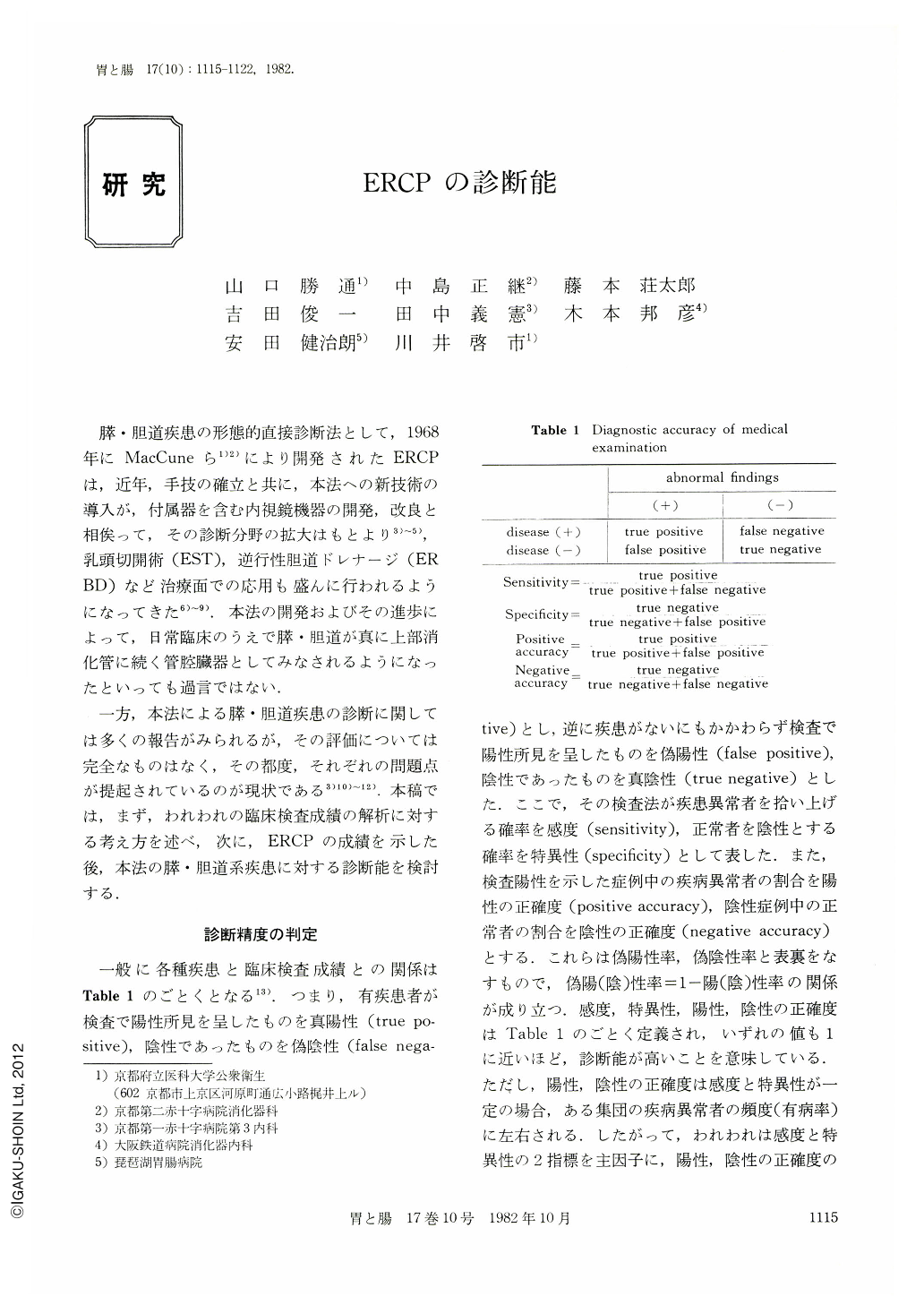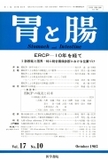Japanese
English
- 有料閲覧
- Abstract 文献概要
- 1ページ目 Look Inside
膵・胆道疾患の形態的直接診断法として,1968年にMacCuneら1)2)により開発されたERCPは,近年,手技の確立と共に,本法への新技術の導入が,付属器を含む内視鏡機器の開発,改良と相侯って,その診断分野の拡大はもとより3)~5),乳頭切開術(EST),逆行性胆道ドレナージ(ERBD)など治療面での応用も盛んに行われるようになってきた6)~9).本法の開発およびその進歩によって,日常臨床のうえで膵・胆道が真に上部消化管に続く管腔臓器としてみなされるようになったといっても過言ではない.
一方,本法による膵・胆道疾患の診断に関しては多くの報告がみられるが,その評価については完全なものはなく,その都度,それぞれの問題点が提起されているのが現状である3)10)~12).本稿では,まず,われわれの臨床検査成績の解析に対する考え方を述べ,次に,ERCPの成績を示した後,本法の膵・胆道系疾患に対する診断能を検討する.
We discussed diagnostic ability of ERCP for cholangio-pancreatic diseases by studying sensitivity and specificity as major factors as well as true positivity and true negativity as minor factors.
To simulate sampling groups of each disease, studied materials were selected from 2, 412 cases in which clinical course was able to be followed for more than three years after the ERCP's study. Definite diagnosis of each disease was made by histological diagnosis which was obtained by operation and autopsy, and existence of cholelithiasis or choledocholithiasis was confirmed by operative findings. Exclusion of malignant tumor was made by histological evaluation or more than three year-uneventful prognosis after the ERCP's study.
Results obtained were as follows
(1) Primary pancreatic cancer: pancreatic cancer was found in 113 out of 1,223 cases in which the ERCP's study was indicated. Diagnostic ability of the ERCP for pancreatic cancer was found to have its sensitivity, specificity, true positivity and true negativity as 0.94, 0.88, 0.44 and 0.99 respectively. Namely, this test had high ability of picking up pancreatic cancer as well as non pancreatic cancer patients. Especially, negative findings for pancreatic cancer had high reliability but somewhat high trend of false positive was observed.
(2) Chronic pancreatitis: analyzing 75 cases of chronic pancreatitis in which pancreatic biopsy was performed, we found the ERCP's sensitivity, specificity, true positivity and true negativity for chronic pancreatitis as 0.87, 0.56, 0.67 and 0.80 respectively. These results indicate the ERCP's diagnostic ability for chronic pancreatitis was satisfactory, but it was difficult to rule out false negative cases.
(3) Choledochal lesions: analyzing operated 246 cases, we found the ERCP's diagnostic sensitivity was 0.94, specificity 0.77, true positivity 0.65, and true negativity 0.96. The ERCP's ability to pick up choledochal lesions was quite high and true negativity was satisfactory. However, we should pay attention for somewhat high false positive findings.
(4) Gallbladder lesions: analyzing the same cases of 3), we found the ERCP's sensitivity in this lesion was 0.55, specificity 0.80, true positivity 0.93 and true negativity 0.23. The ERCP's ability to pick up gallbladder lesions was low but reliability on normal findings was satisfactory. Reliability on abnormal findings in this lesion was also quite high but this result was mainly due to low rate of visualization of the gallbladder than other diseases.

Copyright © 1982, Igaku-Shoin Ltd. All rights reserved.


